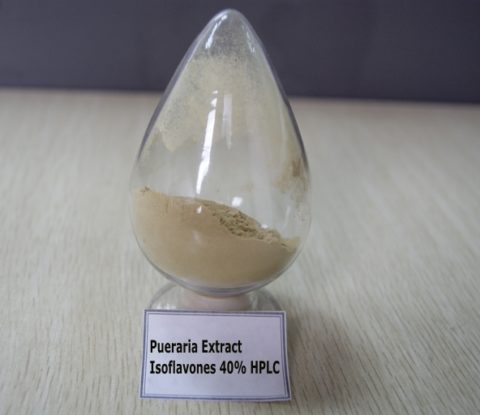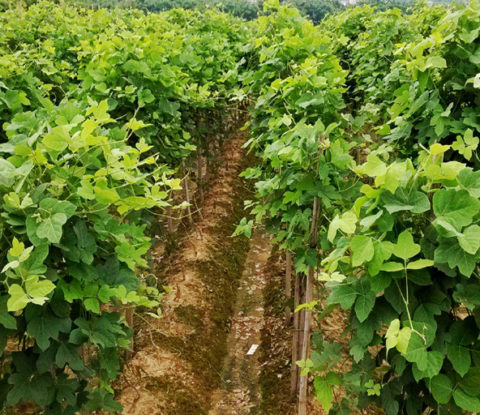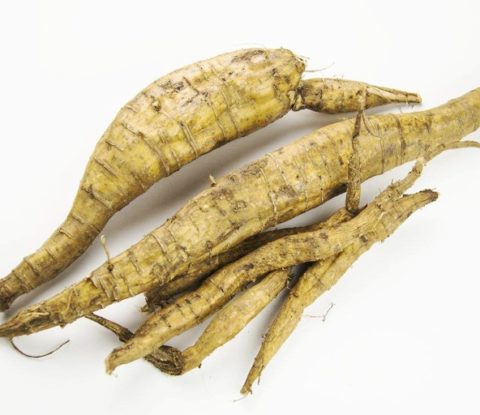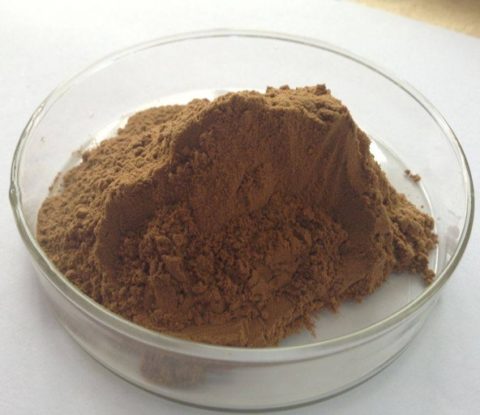
Pueraria Extract, Kudzu Root Extract Powder Isoflavones 40%-98% UV; Puerarin 30%-98% HPLC
As many as 13 isoflavones contained in pueraria root have very good regulating effect on human body, among which, daidzein, daidzein, puerarin and other active substances can promote blood flow of cardio cerebral vessels and retina, relax smooth muscle, relieve spasm, resist cancer and induce differentiation of cancer cells, reduce blood sugar, blood pressure, antioxidant, antipyretic and alcohol, improve memory and enhance immunity and other functions.
Pueraria Extract/Kudzu Root Extract Powder
【Latin name】: Pueraria lobata (Willd.) Ohwi
【Part of used】: Root
【Active ingredient】: Puerarin, Isoflavones
【Specification】: Isoflavones: 40%-98% UV; Puerarin: 30%-98% HPLC
【CAS NO. 】: 3681-99-0(Puerarin)
【Molecular Weight】:416.38(Puerarin)
【Molecular Formula】:C21H20O9(Puerarin)
【Appearance】: Brown yellow to white powder
【Particle size】: 100% pass 80 mesh
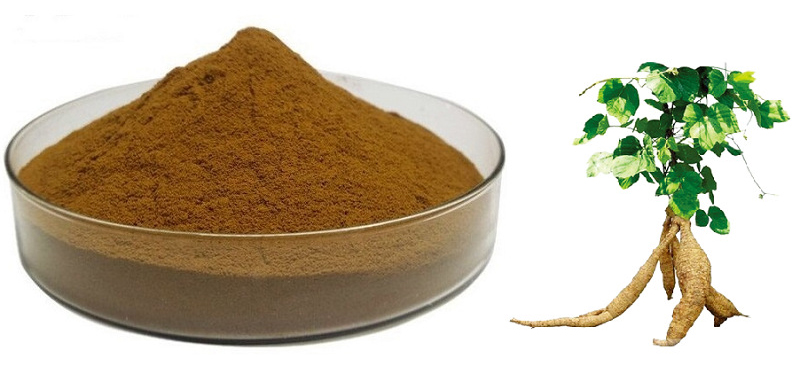
The name kudzu describes one or more species in the genus Pueraria that are closely related, and some of them are considered to be varieties rather than full species. The morphological differences between them are subtle; they can breed with each other, and introduced kudzu populations in the United States apparently have ancestry from more than one of the species. They are: Pueraria montana, Pueraria lobata (P. montana var. lobata), Pueraria edulis, Pueraria phaseoloides, Pueraria thomsonii (P. montana var. chinensis), Pueraria tuberose.
Kudzu is a plant in the genus Pueraria in the pea family Fabaceae, subfamily Faboideae. It is a climbing, coiling, and trailing vinenative to southern Japan and southeast China. Kudzu contains a variety of phytochemicals, which are potent antioxidant compounds found naturally in plants, that help to prevent and treat disease in humans. Kudzu contains the phytochemicals quercetin, which has antihistamine and anti-inflammatory properties, and genistein which works as a free radical scavenger. The most important phytochemicals are, however, the isoflavone compounds — daidzein, daidzin, tectorigenin and puerarin. Kudzu root has been known for centuries in traditional Chinese medicine as ge-gen.
The first written mention of the plant as a medicine is in the ancient herbal text of Shen Nong(about A.D.100). In traditional Chinese medicine, kudzu root is used in prescriptions for the treatment of thirst, headache, and stiff neck with pain due to high blood pressure. It is also recommended for allergies, migraine headaches, inadequate measles eruptions in children, and diarrhea It is also used in modern Chinese medicine as a treatment for angina pectoris.
Indications in Traditional Chinese Medicine
1. High fever of exterior syndromes
Pueraria root has the action of expelling the external wind pathogen and reducing fever by diaphoresis. It can be used for high fever of exterior syndromes due to external contraction either by wind-cold or wind-heat. For wind-cold exterior syndrome, it is used with herbs having efficacy of dispelling wind-cold, such as Ma Huang, Qiang Huo, Fang Feng and so on. For wind-heat exterior syndrome, it can be used with wind-heat-dispersing herbs or heat-clearing herbs such as Bo He, Jin Yin Hua and so on. Because this herb can both dispel external wind and clear internal heat induced by pathogen stagnation, it is usually used to treat exterior syndromes, accumulated pathogens transforming into fire, invading the internal organs, which manifested as fever aggravated, aversion to cold, dryness of the nose and pain in eyes and slight thirst. For example, in the book of Shang Han Liu Shu, the famous decoction named Chai Ge Jie Ji Tang, Ge Gen is used with Chai Hu, Bai Zhi, Qiang Huo, and Huang Qin. This herb also has the action of relieving the stiffness and pain of shoulder and neck which is caused by stagnation of external pathogen, dysfunction of meridian qi and malnutrition of muscles and meridians, and this kind of symptom is mainly seen as wind-cold exterior syndrome. For the exterior excess accompanied by no sweating, it is often used with Ma Huang Tang, such as Ge Gen Tang from the book of Shang Han Lun; for the exterior deficiency accompanied by sweating, it is usually combined with Gui Zhi Tang, just as Gui Zhi Jia Ge Gen Tang from the book of Shang Han Lun.
2. Unsmooth eruption of measures that still at the beginning stage
Pueraria root can both expel the external pathogens and promote the eruption, It is mainly used for the measles first come without adequate eruption. Because of the invasion of wind-heat, it is usually used with with Niu Bang Zi and Sheng Ma which can dispel wind-heat, relieve toxicity, and promote eruption, such as Sheng Ma Ge Gen Tang from the book of Yan Shi Xiao Er Fang Lun (Discussion on Pediatric Prescriptions of Yan Jizhong), Ge Gen and Sheng Ma are mutually reinforced.
3. Thirst due to warm diseases and diabetes
Pueraria root has the effect of promoting the production of fluid and relieving thirst. So it is mainly used for patient with restless thirst. The property of this herb is sweet and cool, so it is fit for the symptom of thirst induced by consumption of fluid due to warm diseases. For this kind of syndrome Ge Gen will be used with Zhi Mu and Shi Gao which have effect of clearing heat and eliminating the fire. For the syndrome of diabetes caused by yin deficiency converting into dryness it will be used with herbs which function as promoting the generation of fluid and tonifying the stomach, such as Tian Hua Fen, Shan Yao and so on. Also Ge Gen has the action of promoting the clear qi of spleen and stomach to ascend upward. For the diabetes caused by qi deficiency of spleen Ge Gen will be used with Ren Shen and Huang Qi, the herbs which can tonify qi so as to help the generation and transformation of body fluid.
4. Diarrhea due to spleen deficiency
Pueraria root can promote the clear qi of spleen and stomach to flow upward. For the patient who suffer from diarrhea caused by deficiency of spleen and collapse of qi which lead to dysfunction of transportation and transformation, Ge Gen will be accompanied by herbs having action of tonifying qi and invigorating spleen, so as to lift up the clear yang and arrest diarrhea. For the patient who suffers from dysentery with fever, Ge Gen will be used together with Huang Lian, Huang Qin and so on which have actions of clearing heat, resolving dampness and detoxifying, so as to expel pathogen from exterior and relieve fever.
Benefits of Pueraria Root/Kudzu Root Extract
Treatment for Alcoholism
Chinese doctors have for centuries used kudzu in a tea form as a treatment for alcoholism. The tea used is called xing-jiu-ling. This traditional application of the herb has gain interest in the scientific community and few studies have been made to investigate the herb’s effectiveness. Thus far, these studies have produced findings with mixed results. While some have shown that it is useful in treating alcoholism others have indicated that the herb is ineffective.
The biochemist Wing Ming Keung at HarvardMedicalSchool, conducted a study in Hong Kong which involved more than 300 people suffering from alcoholism, and in all the cases he examined kudzu showed to be effective in controlling and suppressing the urge to drink alcohol, without side effects. It usually reduced the urge to drink alcohol within one week, and in over 80% of cases the urge to consume alcohol was completely gone within two to four weeks of treatment.
In addition, researchers at Indiana University have discovered two compounds (daidzin and daidzein) in the plant that affect enzymes that break down alcohol in the liver and produce a by-product of the alcohol called acetaldehyde. When this occurs, nausea, facial flushing, and general discomfort soon follows.
Theses two compounds seem to work in similar fashion as the medication disulfiram (Antabus) although Kudzu seems not to induce nausea as much as Antabus but both increase discomfort when alcohol is consumed. Another double-blind study, which lasted for a month and included 38 subjects with alcoholism, found no improvement in those given kudzu, compared with the control group. These results diminished the enthusiasm surrounding the use of kudzu for this purpose. One reason for these negative result may be that the substance daidzin present in the plant is less effective in its purified form and kudzu is more effective when used in its natural state.
Help Breast Cancer Treatment
Many cancers, including breast cancer and some forms of melanoma (a cancer that forms from the pigment-containing cells called melanocytes), are stimulated by the hormone estrogen. Kudzu contains several chemical substances that are very similar to estrogen. One of them, formononetin (an isoflavone), has no effect on the body as such, but when it is converted by the friendly bacteria in the digestive tract to an estrogen-like compound called daidzein, it binds to cells that would normally been activated by estrogen. In short, the substance blocks estrogen at the activator sites on breast cancer cells, without stimulating these cancer cells to divide like estrogen would. Studies in Japan, USA and Finland have shown that isoflavones are clearly linked to reduced occurrences of breast and uterine cancer.
Heart Disease
Kudzu is often used as a remedy for heart and circulatory problems and high blood pressure. Flavonoid-like substances in kudzu contribute to an increase in blood circulation and flow in the arteries of the heart and reduces the heart’s need for oxygen. These substance also relax the muscles that surround the left coronary artery and lower the heart rate. Kudzu has also antioxidant properties which could slow down the narrowing of the arteries. In a clinical study, kudzu was used as a treatment for angina pectoris (chest pain due to coronary heart disease). The duration of the study was 4 to 22 weeks. Of 71 patients 29 showed improvement, 20 showed some improvement, while 22 patients showed little or no improvement.
Application of Pueraria Root/Kudzu Root Extract
1. Applied in food field, puraria isoflavones can be used in foods and health products,to lower blood pressure and blood-fat;
2. Applied in pharmaceutical field, puraria isoflavones is widely used in biopharmaceuticals and API of cardiovascular system agents in China. As a kind of Chinese medicine injectio, puerarin is a common drug for heart and cerebrovascular disease;
3. Applied in cosmetics field, the phytoestrogen effect of puerarin can relieve symptom caused by decrease in estrogen level and aging, such as mastoptosis, crinkle, and decrease in skin vitality and leukotrichia. Hence, it is frequently used in breast cream, eye cream and skin cream.
